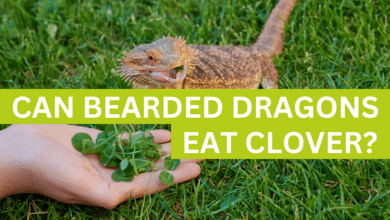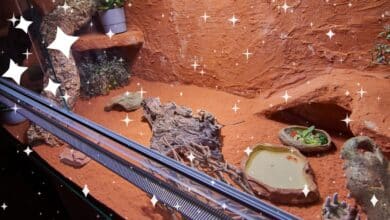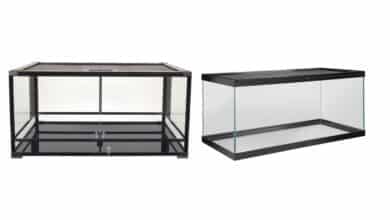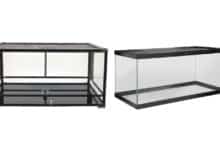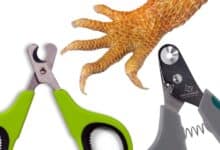Ultimate Guide to Bearded Dragon Third Eye Facts & Function
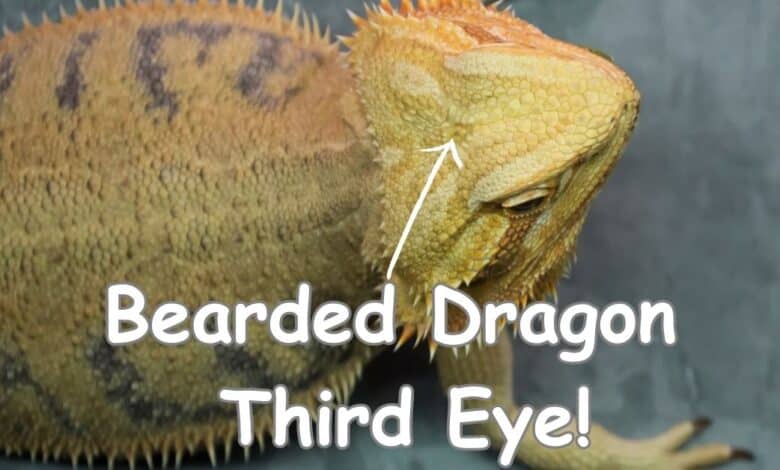
If you are a bearded dragon owner, you may have heard about the “third eye” that some reptiles have. This “third eye” is a small, light-sensitive organ on the bearded dragon’s head.
While it is true that bearded dragons have a small, light-sensitive organ on the top of their head known as the “third eye,” it is not an ordinary eye but an organ. This organ is also called the parietal eye, solar eye, pineal eye, or pineal gland, and it is present in many reptiles, including some lizards and turtles.
While the parietal eye may not be an actual “third eye,” it is still an essential part of the bearded dragon’s anatomy. As a bearded dragon owner, it can harm your beardie by not understanding the function of this organ and how it can affect your pet’s health and behavior.
Contents
What is the Parietal Third Eye of a Bearded Dragon?
The third eye, the parietal eye, is a small, circular scale-looking part of the pineal complex between its two regular eyes on top of the bearded dragon’s head. Unlike its two eyes used for visual seeing, the bearded dragon third eye sees more in a sensory way.
Where is a Bearded Dragon’s Third Eye?
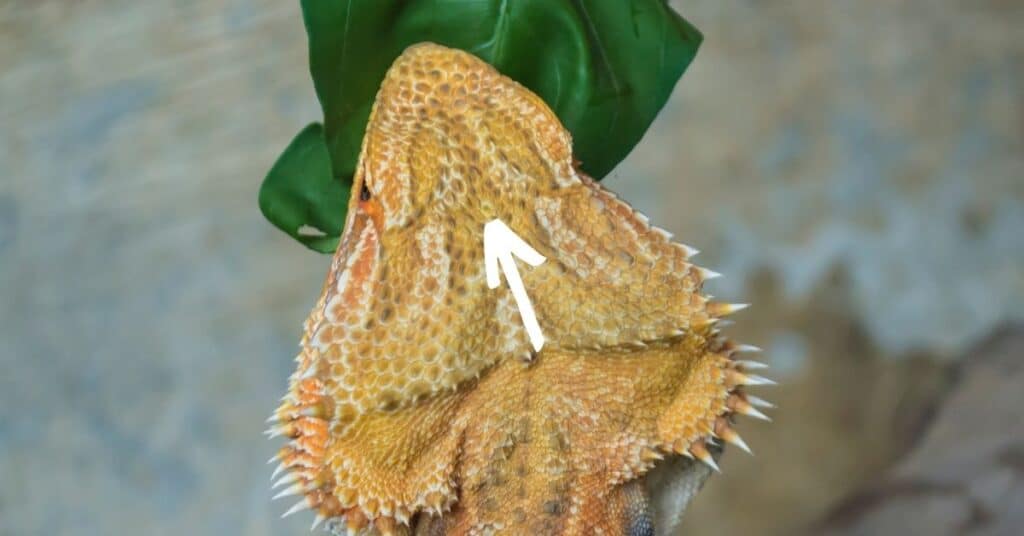
The third eye is on the top of the bearded dragon’s head, towards the back of the facial skull between its two eyes. It appears as a small, circular scale with a thin, translucent layer of skin, allowing light to pass through the lens underneath.
What Does a Bearded Dragon‘s Third Eye Look Like?
The third eye is a small, slightly raised circular scale above the surrounding skin. It is usually a different color than the other scales on the head, often darker or lighter. The lens of the third eye is transparent and round, and the organ within is sensitive to light.
How Is A Bearded Dragon’s 3rd Eye Different Than A Normal Eye?
The parietal eye cannot form images like a regular eye. Instead, it is sensitive to changes in light and dark and can help the bearded dragon regulate its circadian rhythm or internal clock. This third eye is especially important for bearded dragons in captivity, as it can help them adjust to environmental changes, such as lighting or temperature.
The third eye is also different in terms of its anatomy. Unlike a normal eye’s cornea, iris, and pupil, which connect to the optic center of the brain, the third eye has a single lens that focuses light onto the retina. The retina connects to the pineal gland, which produces hormones that regulate the bearded dragon’s body clock and other physiological functions.
How Do Bearded Dragons Use Their Third Eye?
The bearded dragon’s third eye is a photosensory organ responsible for detecting light and plays an essential role in regulating various biological functions in the bearded dragon’s body.
Below is a list of ways a bearded dragon can use this light-sensitive organ to help it regulate many of its natural biological functions:
Detecting Light
The third eye of a bearded dragon is a crucial component of their photoperiod of light, which helps regulate their biological clock and circadian rhythms. This photosensory organ can detect light even when their eyes are closed, allowing them to sense the presence of bright white light and adjust their body temperature accordingly.
The third eye helps to sense when it is time to find a spot to sleep as night has fallen or to wake up when the morning light starts shining.
Temperature Regulation
The third eye also assists in thermoregulation, maintaining the bearded dragon’s body temperature. By detecting the intensity of light and heat from the Sun or artificial light sources, the third eye helps the bearded dragon regulate its body temperature and stay comfortable in its enclosure.
Sleep
The third eye of a bearded dragon also plays a role in their sleep patterns. When the third eye detects darkness, the bearded dragon’s brain releases melatonin to initiate sleep and rest. The ability to sense light and dark with this third eye helps the bearded dragon maintain a healthy sleep-wake cycle and internal clocks.
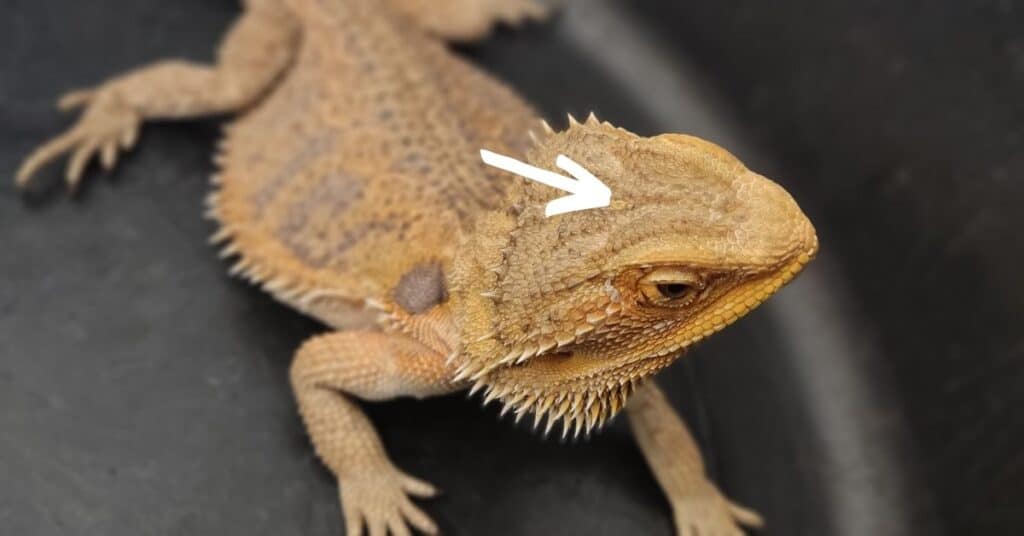
Regulate Hormones & Biological Processes
The third eye is also responsible for regulating the production of hormones and other biological processes in the bearded dragon’s body. It can control direct hormone production or send signals based on what it senses to the pineal complex, which manages hormone regulation, reproduction, and other biological functions.
Sense Predator Movement Above
The third eye of a bearded dragon is also essential for its survival in the wild. It helps them sense the movement of potential predators above them by noticing shadows and quick changes in light from birds of prey and allows them to take cover and avoid danger.
If you ever have a bearded dragon outside and notice it quickly looks up into the sky with one of its visual-seeing eyes, it may have sensed a bird or something else moving in the sky with its third eye. When confirmed with one of its two visual eyes, it will often lower its head or run to a place to hide.
Helps With Navigation
The third eye also plays a role in navigation for bearded dragons. It acts as a compass by helping them sense the Sun’s direction, allowing them to orient themselves and navigate their natural habitat more effectively.
What Does the Third Eye NOT Do?
Here are a few things that the third eye does not do:
- The third eye does not see like the other two eyes. It does not have a lens or retina and connects to the brain differently.
- Contrary to popular belief and myths, the third eye does not provide the bearded dragon with psychic ability.
Must Know Care Tips for a Bearded Dragon‘s Third Eye
Here are some must-know tips to properly care for your bearded dragon taking its third eye into account:
Do Not Cover a Bearded Dragon’s Third Eye On Purpose
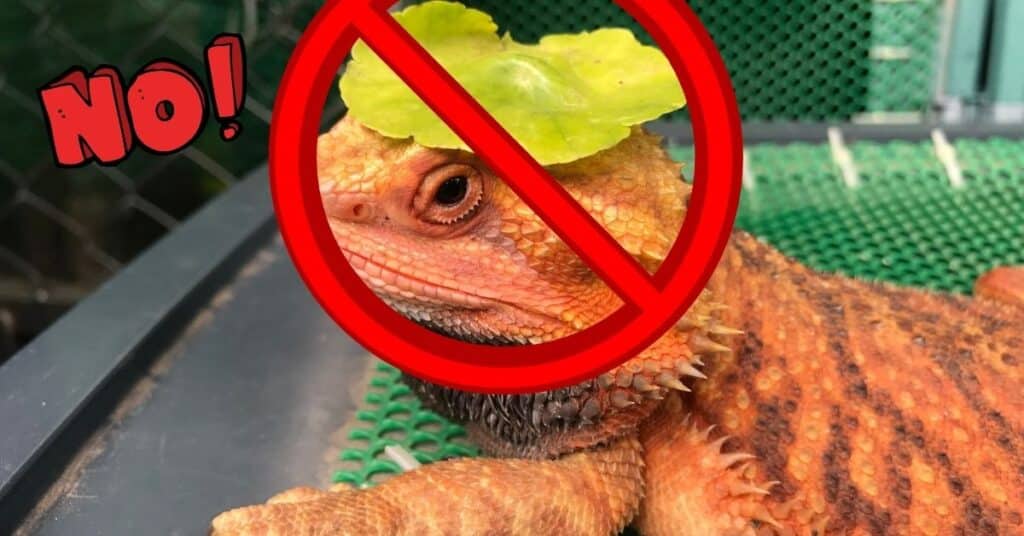
The most fundamental thing owners should not do is cover the third eye on purpose. It would be as if someone came up behind you and covered one of your eyes. However, even worse it then started impacting your biological chemistry. Never deliberately cover their third eye.
Turn Off the Lights at Night
The third eye is sensitive to light and can disrupt your bearded dragon’s sleep if exposed to light at night. Turn off lights at night to allow your bearded dragon to get adequate rest.
Overexposing your bearded dragon to light by forgetting to turn off the lights for a night feels like it does for humans when we stay up for more than 24 hours straight.
Use A Timer on the Lights
Using a timer on the lights is best to ensure your bearded dragon receives the proper amount of light each day. A timer can also help regulate the light cycle and prevent overexposing the third eye to light.
Again, we can’t stress the importance of ensuring the lights turn off at night to maintain your bearded dragon’s natural circadian rhythm. Please consider using a reptile light timer.
Do Not Alternate Between Natural and Artificial Light
While natural sunlight benefits your bearded dragon, it is best to only provide it with natural light sometimes – such as when taking it outside to run for a bit. All light is not the same – the intensity of ultraviolet light will be different from indoor basking and UVB lights compared to the natural Sun. This change from synthetic to natural light can confuse your bearded dragon’s internal clock and disrupt its sleep cycle.
Once you have proper lights for your bearded dragon, stick to a consistent light cycle using the same wattage of lights daily to keep your bearded dragon healthy.
Do Not Approach Your Beardie From Above
Bearded dragons have an instinct to protect themselves from predators approaching from above. If you come to your bearded dragon from above, it may become stressed or frightened, causing its third eye to become more prominent – a sign of stress.
FAQ
The bearded dragon’s third eye, or parietal eye, does not require any special care. It is a natural part of the bearded dragon’s anatomy and functions independently of the other two eyes.
The bearded dragon’s third eye does not have an eyelid. Instead, it has a transparent scale covering it that protects it from damage. This scale can become cloudy or shed, a normal process and nothing to worry about.
However, if you notice any discharge or swelling around the third eye, it can be a critical condition. It would be best to consult a veterinarian right away.
Bearded dragons in captivity use their third eye less frequently than their other two. They will mainly use it as a sensory organ to know when to bask and lay in a spot to cool down.
The third eye in captivity will still help them detect light and dark changes to regulate the bearded dragon’s circadian rhythm. Although it is used for these functions less since you, their owner, control their habitat.
Avoid touching a bearded dragon’s third eye, as this is an extremely sensitive part of its body. If petting their head, it is best to stay on either side of the third eye to prevent accidentally causing any harm to it.
No, bearded dragons cannot see out of their third eye. This third eye can only sense changes in light, triggering them to look up with their other two eyes that can actually see images.
Overall, the third eye of a bearded dragon is a fascinating and essential part of their biology. It is crucial in regulating their body temperature, circadian rhythms, hormone production, and other biological functions.
Understanding how bearded dragons use their third eye can help you provide better care for your pet and ensure they thrive in their enclosure. Following these tips ensures that your bearded dragon will live a long, healthy, and happy life in their tank with you.

